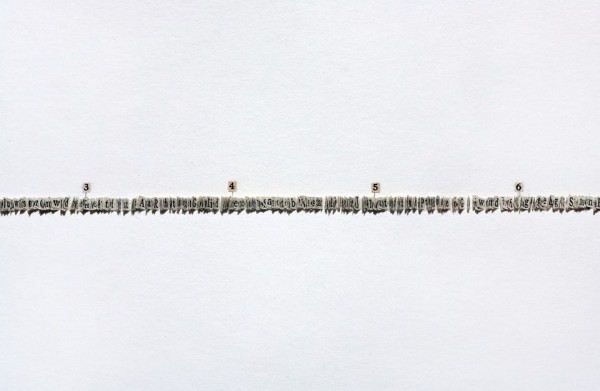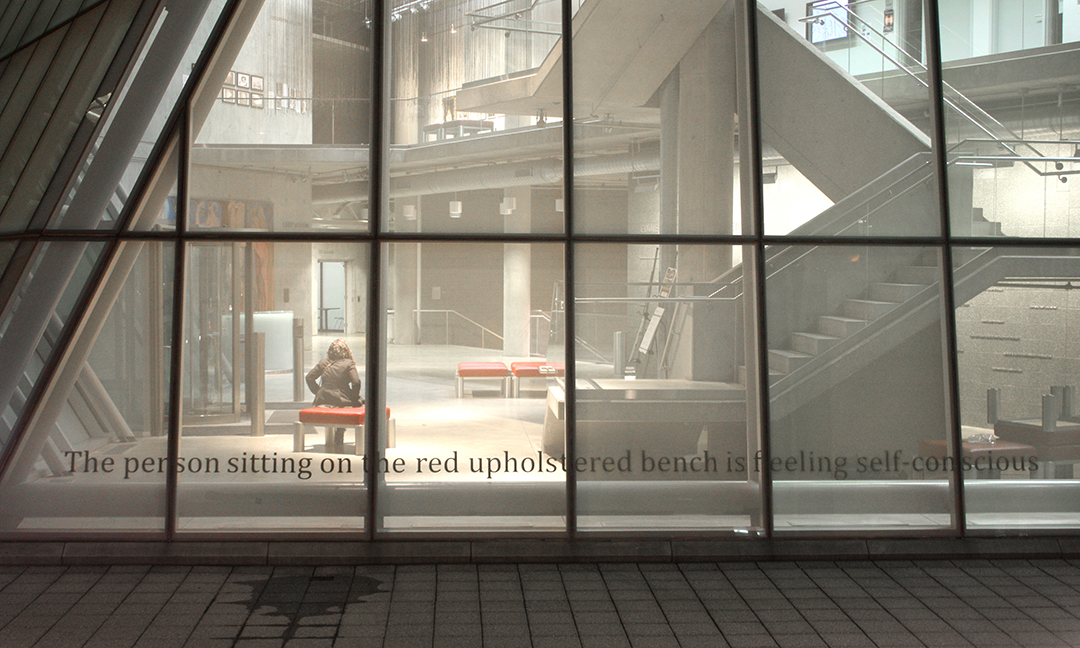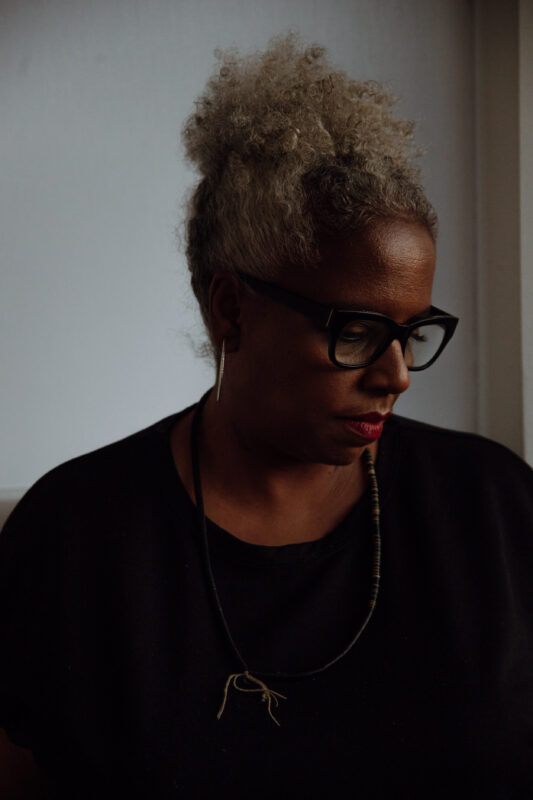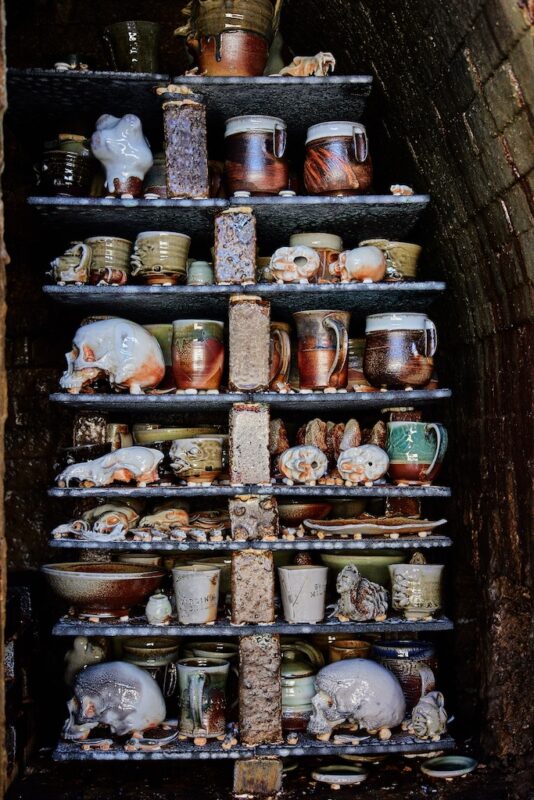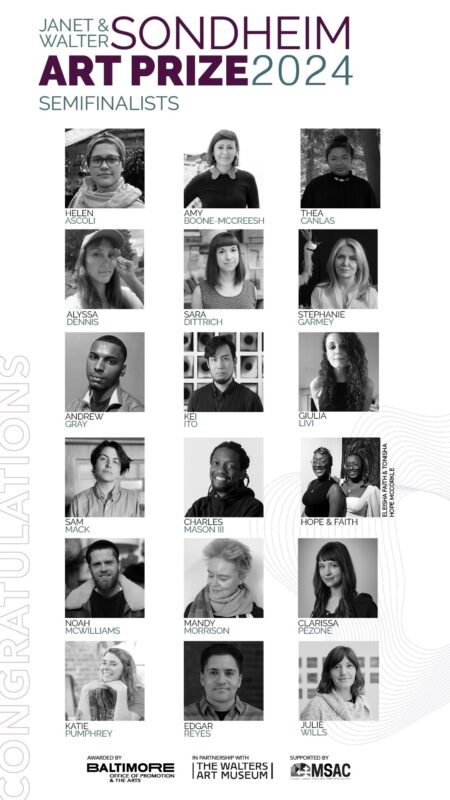Baltimore can get grim in late autumn, with matte gray skies and lingering cold rain. One recent such afternoon, the sun just going down, I came to an address provided by Nick Wisniewski. The door was embedded in a long, anonymous façade fronting a small street north of Greenmount Cemetery. Across the road was a block of condemned row homes crisscrossed with caution tape. On the other side of the door lay The Compound, a radical experiment in social organization, alternative economics, urban agriculture, and political art.
Wisniewski met me at the door and we started in on a tour. A former forklift factory, the space sprawls over 20,000 square feet, generating its own bewildering internal geography. Up front, the former warehouse offices have been pressed into service as an impromptu gallery and event space. Through a door to the left, The Alternative Press Center maintains a library of independent media. After another series of doors, through a maze of rooms, the space opened into a generous double-height common area. A large kitchen with hand built cabinets formed one side of the room; small studio apartments fanned out on the other sides. A pot-bellied woodstove sat in the center of it all, anchoring the living area.
“We wanted something that had enough space that allowed us to experiment with anything we could think of,” Wisniewski said. He moved in, along with four other collaborators, in 2010. The purchase had wiped out their savings, so they had no choice but to start living there right away.
“The first couple weeks we did this intense ad hoc building where we creating a temporary kitchen and temporary bath,” Wisniewski said. “No banks would give us money. Everyone thought we were nuts.” Gradually, however, the space took shape as an accretive, participatory process. Members of the co-op voted on projects and pooled their resources to build them out. The kitchen came first, then bathrooms, followed by a laundry room, all underpinned with a new radiant floor slab.
Outside the back door, off of the common space, was the yard. A huge cistern towered over the parking lot, hooked up to catch rainwater from the roof. Firewood was everywhere, both stacked neatly by the door and piled haphazardly in the grass. In the side yard, a chicken coop and hoop house shared space with beehives and raised beds. Wisniewski and his collaborators were raising about a dozen laying hens. Inside the hoop house, rabbits were housed in mobile hutches that were rotated over the beds to build up the soil. A huge mural of a crow, black paint on a white garage, kept a doleful watch over the whole scene. Back inside, studios stretched off in zig-zagging wings, housing a co-op woodshop, a coffee roaster, several sculptors, and a future recording studio just beginning construction.
The micro-agriculture experiments grew out of two earlier projects, Camp Baltimore and Participation Park. Camp Baltimore was a series of walking tours, publications, and public actions that challenged the Hopkins-fueled redevelopment on the city’s east side. Sponsored by the Contemporary, the project culminated in a trailer that traveled the neighborhoods in the summer of 2006.
“We were thinking of it as an oppositional device that would be able to take over public space,” Wisniewski said. After that project wound down, the collective behind it atomized. “Some people in the group became more politicized,” he said. “Others were very much interested in the aesthetic experimentations of these things. So it split.”
Wisniewski formed a new group with two friends, Dane Nester and Scott Berzofsky. They dubbed themselves the Baltimore Development Cooperative, a sly poke at the city agency that consolidated land for the Hopkins project. The BDC launched Participation Park in 2007, squatting 12 vacant lots on Forrest Street in Johnston Square.
“I think we were very impacted by the condition of the city, all the abandonment, all the vacant land, unemployment, deindustrialization,” Wisniewski said. “It’s a pretty bleak city to a certain degree.”
The trio started by “just being present,” occupying the land, and meeting neighbors, slowly asserting a passive ownership of public space. As time wore on, they began to regenerate the soil and plant vegetables. They established a CSA to share food with local residents. In collaboration with Red Emma’s, some of what they grew was cooked for a series of supper clubs called Stew. Diners paid upfront, cooks donated their labor, and artists gave presentations between courses. At the end of the night, participants voted on and awarded the proceeds to their favorite project. “[We were] experimenting with models for projects that don’t really get a lot of funding,” Wisniewski said.
Two years after starting, in a decision that took many by surprise, Participation Park won the Sondheim Prize. Wisniewski was just 27. During our interview, he never mentioned the prize or the resultant show at the Baltimore Museum of Art. The BDC brought their occupational strategies to the sidewalk in front of the museum, building a geodesic dome from scavenged materials that hosted community happenings.
Throughout our talk, Wisniewski was retiring and discursive, meandering through the evolutions of his projects. Bundled against the November chill, wearing a week’s worth of beard, he repeatedly deferred to the co-op and gently refused to be photographed. I didn’t press him on the subject, but it seemed to me that recognition of the project may have shifted its center of gravity. “Questions of economy became more present the longer we worked on it,” he told me. “It was a precarious lifestyle to live.”
The warehouse was a way to make Participation Park permanent and create a (relatively) stable platform for experimenting with alternative economic systems. When asked about inspiration, Wisniewski mentioned political philosophers David Harvey, Henri Lefebvre, and Pierre-Félix Guattari. All Marxists, their work explores ideas around the individual’s right to the city and creation of shared social space.
“[They] inspired us to think about an aesthetic production that was more than just this visualization but was very much part of this political social and environment landscape,” Wisniewski said. “We were trying to create these integrated systems. In some ways this place is interested in that.”
Lefebvre and Guattari were most intellectually active during the 1970’s, influencing a wide array of leftist architects and designers in that era. Architect Paolo Soleri folded many ecosophy principles into the design of Arcosanti, an attempt to make a new kind of dense urban environment that produced its own food and energy. Steve Baer, an engineer based in New Mexico who helped build Drop City, has spent his career attempting to integrate architecture and energy production while reaching a sort of détente with capitalist practices. The ghost of Buckminster Fuller hovers over all of these thinkers with his visions of an egalitarian, eco-technocratic society. In many ways, the BDC is a bridge between that idealistic, sunburnt era and a future shadowed by the prospect of real ecological peril.
The Museum of Modern Art, in New York, is currently showing and exhibition called Uneven Growth: Tactical Urbanisms for Expanding Megacities. It explores strategies for feeding and housing a rapidly expanding and urbanizing world population pinched by resource scarcity. The Compound nestles neatly into that chaotic framework, a home-cooked response to an increasingly out-of-control world. Socially and intellectually porous, saturated with a patient, cautious optimism, Wisniewski’s “oppositional device” has found a permanent foundation.
“We have a really great relationship with all of our neighbors, they’re invited to all of our events and we share resources. We’ve really tried to embody those same sorts of principles that we were working with at Participation Park. We look out for each other. They call and are like ‘y’know, someone’s walking around your house’ or ‘your chickens are in the middle of the alley,’” Wisniewski told me, laughing.
Our conversation was interrupted by a phone call from a neighborhood kid that he had hired to help around the woodshop. It was payday, and Wisniewski had responsibilities to attend to. He showed me to the front door and slipped back into the half-lit corridor, preparing to be present for someone else.
Will Holman is a writer, designer, and project coordinator for the Baltimore Arts Realty Company. His first book, Guerilla Furniture Design, is out from Storey Publishing in March, 2015. Follow him: @objectguerilla. Will’s 2014 List includes fine art, design, architecture, and innovative ideas from Baltimore and beyond.
